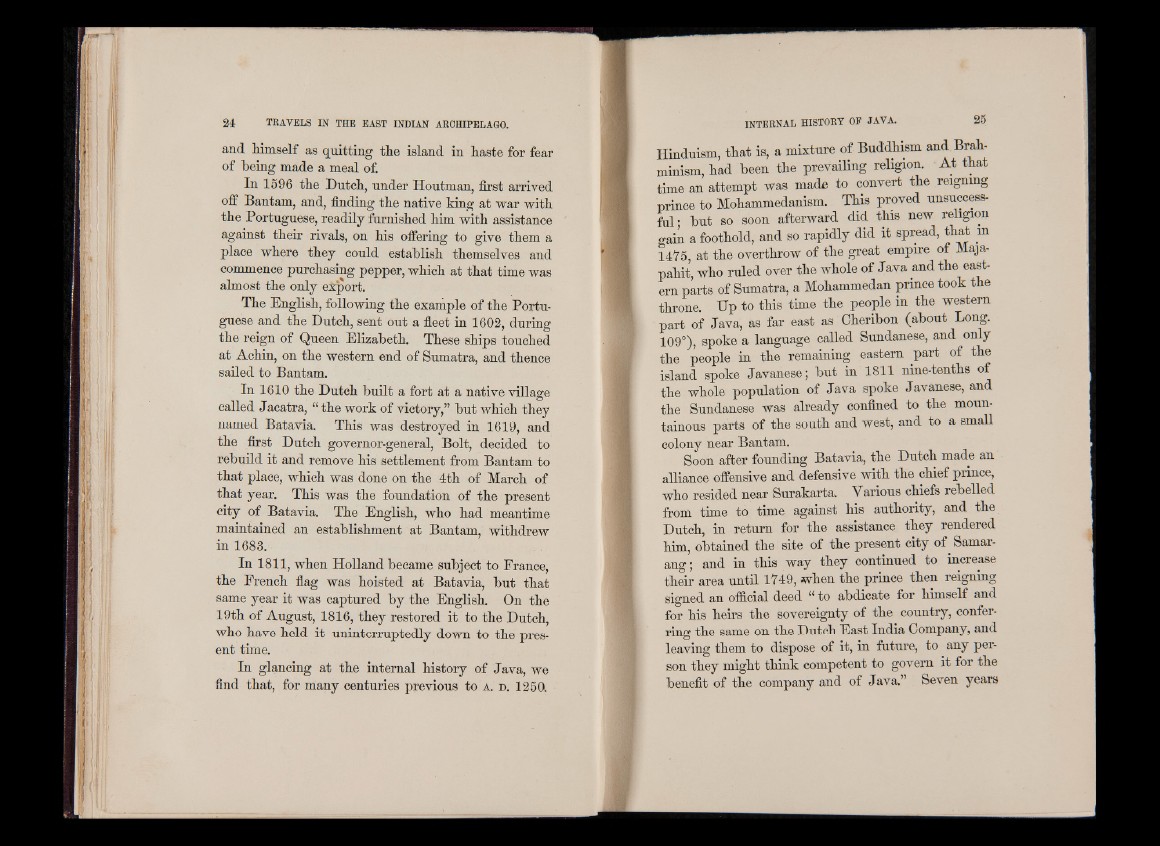
and himself as quitting the island in haste for fear
of being made a meal of.
In 1596 the Dutch, under Houtman, first arrived
off Bantam, and, finding the native king at war with
the Portuguese, readily furnished him with assistance
against their rivals, on his offering to give them a
place where they could establish themselves and
commence purchasing pepper, which at that time was
almost the only export.
The English, following the example of the Portuguese
and the Dutch, sent out a fleet in 1602, during
the reign of Queen Elizabeth. These ships touched
at Achin, on the western end of Sumatra, and thence
sailed to Bantam.
In 1610 the Dutch built a fort at a native village
called Jacatra, “ the work of victory,” but which they
named Batavia. This was destroyed in 1619, and
the first Dutch governor-general, Bolt, decided to
rebuild it and remove his settlement from Bantam to
that place, which was done on the 4th of March of
that year. This was the foundation of the present
city of Batavia. The English, who had meantime
maintained an establishment at Bantam, withdrew
in 1683.
In 1811, when Holland became subject to France,
the French flag was hoisted at Batavia, but that
same year it was captured by the English. On the
19th of August, 1816, they restored it to the Dutch,
who have held it uninterruptedly down to the present
time.
In glancing at the internal history of Java, we
find that, for many centuries previous to A. d . 1250.
Hinduism, that is, a mixture of Buddhism and Brah-
minism, had been the prevailing religion. -At that
time an attempt was made to convert the reigning
prince to Mohammedanism. This proved unsuccessful
but so soon afterward did this new religion
o-ain a foothold, and so rapidly did it spread, that m
1475, at the overthrow of the great empire of Majar
pahit, who ruled over the whole of Java and the eastern
parts of Sumatra, a Mohammedan prince took the
throne. Up to this time the people in the western
part of Java, as far east as Cheribon (about Long.
109°), spoke a language called Sundanese, and only
the people in the remaining eastern part of the
island spoke Javanese; but in 1811 nine-tenths of
the whole population of Java spoke Javanese, and
the Sundanese was already confined to the mountainous
parts of the south and west, and to a small
colony near Bantam.
Soon after founding Batavia, the Dutch made an
alliance offensive and defensive with the chief prince,
who resided near Surakarta. V arious chiefs rebelled
from time to time against his authority, and the
Dutch, in return for the assistance they rendered
him, obtained the site of the present city of Samar-
ang; and in this way they continued to increase
their area until 1749, when the prince then reigning
signed an official deed “ to abdicate for himself and
for his heirs the sovereignty of the country, conferring
the same on the Dutch East India Company, and
leaving them to dispose of it, in future, to any person
they might think competent to govern it for the
benefit of the company and of Java.” Seven years